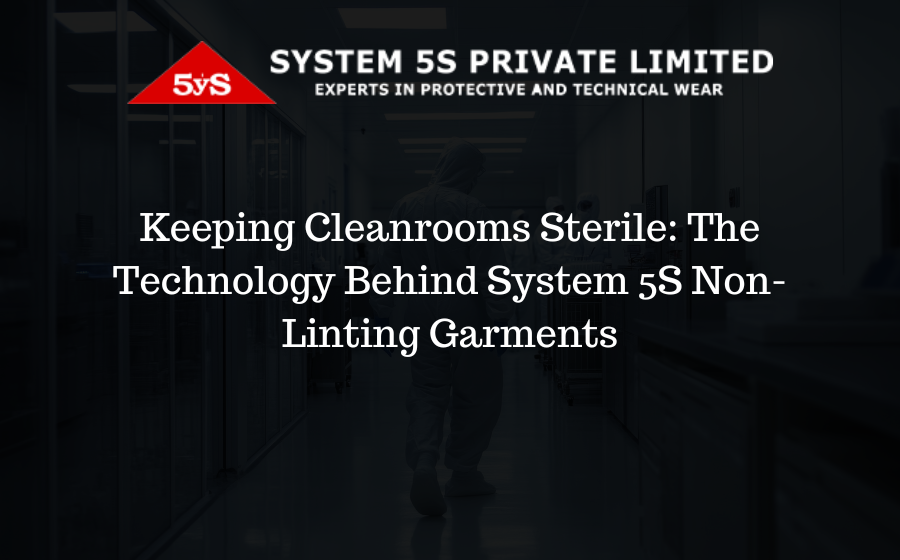
In industries where precision and cleanliness are paramount, such as pharmaceutical manufacturing, biotechnology, and electronics, maintaining a sterile environment is not just important—it’s critical. Contamination control is a constant challenge, as even the smallest particles or microbes can jeopardize the integrity of the product or process. To combat these risks, cleanroom technology has evolved significantly, and one of the most crucial components in contamination control is the apparel worn by personnel.
System 5S, a leader in protective and technical wear, has developed cutting-edge non-linting garments that are designed specifically for use in cleanrooms, offering superior contamination control. In this blog, we will explore the importance of non-linting garments in cleanrooms, the advanced technology behind System 5S garments, and how these products ensure that sterile environments remain uncontaminated.
Cleanrooms are environments where airborne particles, contaminants, and pollutants are controlled to specified limits. These spaces are designed to prevent contamination that could compromise the quality of the processes or products being developed or manufactured. Personnel are one of the largest potential sources of contamination in cleanrooms, as human movement can generate particles, skin cells, and bacteria that may settle on surfaces or float in the air.
Non-linting garments are specifically designed to minimize particle shedding and control contamination. These garments ensure that fibers, dust, and other particles from clothing do not become airborne or come into contact with sterile surfaces. By reducing the risk of contamination from the clothing itself, non-linting garments help maintain the integrity of cleanroom environments and protect the processes and products within them.
System 5S has leveraged the latest advancements in material science and garment construction to create non-linting garments that offer superior contamination control, comfort, and durability. Here are some of the key technologies incorporated into these garments:
1. Non-Linting Fabrics
The primary feature of System 5S cleanroom garments is their use of non-linting fabrics, which are engineered to prevent fiber shedding. These fabrics are made from tightly woven or non-woven materials that significantly reduce the release of fibers into the cleanroom environment. The fabrics undergo rigorous testing to ensure they meet the stringent particle emission standards required for cleanrooms.
Key Benefits of Non-Linting Fabrics:
2. Antistatic Properties
Static electricity can attract and hold particles, posing a significant risk in cleanroom environments. System 5S non-linting garments incorporate antistatic materials and coatings that dissipate static charges, preventing the buildup of particles on the surface of the garments.
Key Benefits of Antistatic Properties:
3. Seamless Construction
System 5S non-linting garments feature advanced construction techniques to minimize particle shedding from seams. Traditional sewn seams can be a source of fiber shedding and contamination. To counter this, System 5S uses seam-sealing technology that reduces the risk of particles becoming trapped or released from seams.
Key Benefits of Seamless Construction:
4. Wash Care Repair & Maintenance (WCRM)
System 5S’s garments are designed to endure multiple sterilization cycles without compromising their integrity. Additionally, System 5S offers a Wash Care Repair and Maintenance (WCRM) service to ensure that garments remain in optimal condition. This includes routine inspections, repairs, and specialized cleaning techniques that prolong the life of the garments while maintaining their non-linting properties.
Key Benefits of WCRM:
System 5S non-linting garments are designed for a wide range of industries where contamination control is critical, including:
1. Pharmaceutical Manufacturing
Pharmaceutical companies rely on sterile environments to ensure the safety and efficacy of their products. System 5S non-linting garments are essential in reducing contamination risks during drug development, testing, and manufacturing.
2. Biotechnology
In biotech labs, where cellular and molecular processes are highly sensitive to contamination, non-linting garments ensure that experiments and production remain free from unwanted particles and microorganisms.
3. Electronics and Semiconductor Manufacturing
Electronics manufacturing, especially in semiconductor production, requires ultra-clean environments to avoid damaging delicate components. The antistatic properties of System 5S garments are particularly beneficial in these industries, where even minor static charges can lead to significant damage.
The cleanroom industry is constantly evolving, and System 5S is at the forefront of this evolution. As technology advances and the need for even stricter contamination control measures grows, System 5S continues to innovate. Future developments in non-linting garments are likely to include even more advanced materials, enhanced comfort features, and further improvements in durability and functionality.
Maintaining a sterile environment in cleanrooms is critical for industries where contamination can lead to catastrophic consequences. System 5S non-linting garments are designed to provide superior protection against particulate contamination, ensuring that cleanrooms remain uncontaminated and that products and personnel are safeguarded. With cutting-edge fabric technologies, antistatic properties, seamless construction, and ongoing maintenance services, System 5S offers a comprehensive solution to cleanroom contamination control.
Trust System 5S for your cleanroom garment needs and experience the peace of mind that comes with knowing your sterile environments are fully protected. For more information, visit System 5S today.